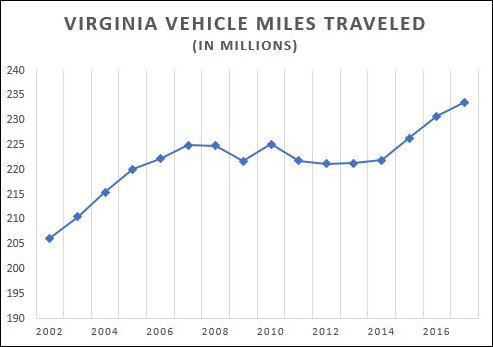Now that we’ve learned that Millennials have the same driving habits as previous generations — as soon as they can afford to, they buy their own cars and drive them just as much (see previous post) — we can dispense with the delusion that their enlightened consumer preferences will induce them to abandon the practice of driving solo in their own cars and take to buses, bicycles and mass transit in large numbers regardless of what else is happening in the economy.
After writing the previous post, I decided to revisit some numbers that I haven’t seen published in years — Vehicle Miles Traveled in Virginia. The updated numbers are startling. After hitting a seven-year plateau, VMT between 2014 and 2017 resumed the upward climb on the same trajectory as seen during the 2000s real estate boom and heyday of suburban sprawl.
Back in the 2000s, I spilled considerable digital ink warning that the upward trend would not continue indefinitely, and that state projections of unfunded transportation needs in the multiple tens of billions of dollars were not warranted. Lo and behold, along came a recession and a rediscovery of the value of walkable urbanism, and VMT flattened out. Transportation crisis averted. But now VMT is climbing again, and there is no ignoring it. Roads are getting congested again.
What’s going on? My theory is that the demand for walkable communities, where people can drive less, is under-served. To some degree, growth and development have shifted back to core urban areas in Virginia, stimulating urban revitalization, but zoning and NIMBYism make it impossible for core jurisdictions to build enough to meet demand. So home builders go where they can build — in outlying counties which have plenty of zoning approvals left over from the previous decade.
I hypothesize that many Millennial families aren’t moving into the kinds of walkable, mixed-use neighborhoods they’d prefer, but their desire to buy their own homes and to raise children in decent suburban public schools impels them into auto-dependent neighborhoods. That’s not what they’d wish for in an ideal world, but given the choices they’re offered, they’re willing to pay the price.
Now it’s time to ask the question: Is Virginia heading to the transportation underfunding crisis predicted in the 2000s but delayed by seven years? The answer is: probably, but not inevitably. It all depends on how fast Virginia cities and counties can mend their urban fabric to accommodate walkable urbanism and transform the economics of mass transit, which remains a financial sinkhole. It also depends on how the new automotive revolution — electric vehicles, self-driving cars, Mobility as a Service — transforms driving habits. The fact is, we don’t know the answers.
However, I can say two things with confidence. The usual suspects will re-start the clamor that we need Mo’ Money for roads, bridges, highways and transit. And straight-line projections of current trends are likely to be wrong.



